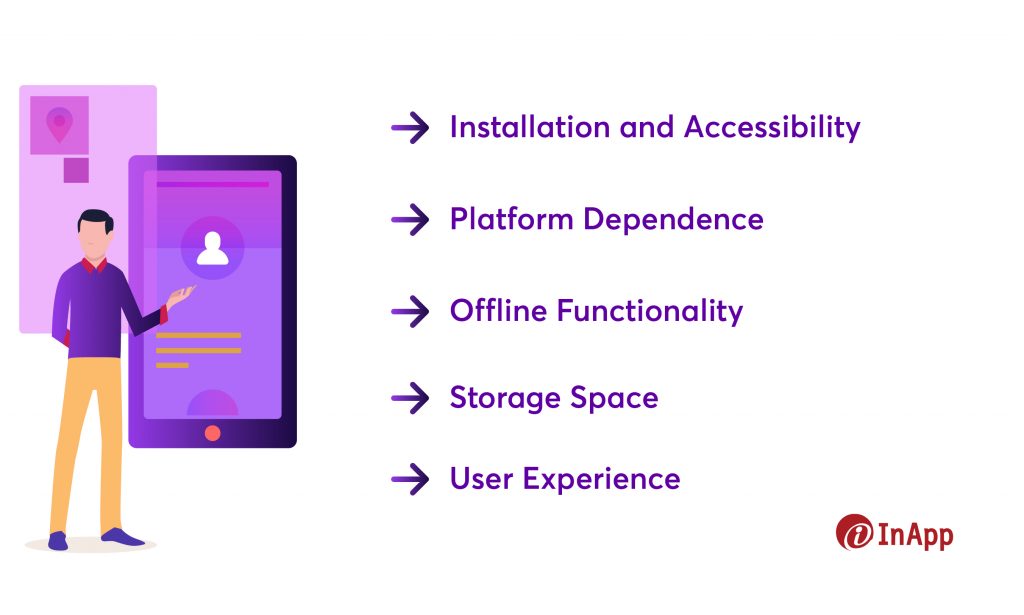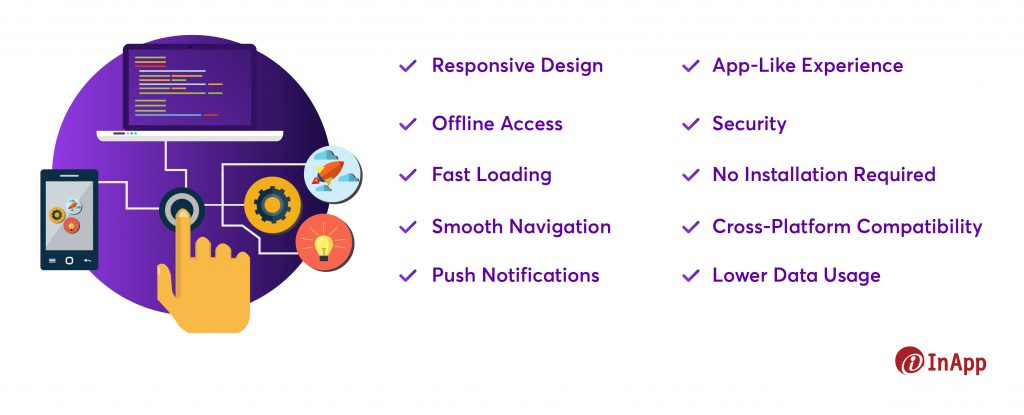Over the past few years, a new trend has emerged in the IT landscape. Companies from startups to large-scale enterprises are moving away from purely native applications to the realm of progressive web applications (PWA). The primary reason for this shift is the compelling user experience benefits offered by PWAs.
Because PWAs offer features like seamless offline access, faster load times, and cross-device compatibility, they have gained attention as they bridge the gap between the responsive nature of websites and the performance of native apps
This article will discuss in detail progressive web apps and their impact on user experience.
What are Progressive Web Apps?
Progressive Web Apps (PWAs) are web applications that offer a seamless, app-like experience to users. They are a perfect amalgamation of web pages and mobile applications, providing users with the best of both worlds.
Progressive Web Apps (PWAs) offer seamless offline access, swift loading, and device compatibility, enhancing user experience by combining the best of websites and native apps for modern interactions.
However, PWAs are not without limitations and trade-offs. Some main limitations of PWAs include limited access to certain device features, potentially slower performance on low-end devices, and less discoverability compared to native apps on app stores. Additionally, not all browsers fully support all PWA features uniformly, leading to inconsistent experiences across different platforms.
How are Progressive Web Apps Different From Native Apps?
While Progressive Web Apps (PWAs) and native apps have distinct characteristics, they can be challenging to differentiate at times.
Here are some of the main differences between a native app and a progressive web app.

1. Installation and Accessibility
Native apps are downloaded and installed from app stores, whereas Progressive Web Apps (PWAs) are accessed through web browsers, eliminating the need for installation and enabling instant access. Some popular examples of progressive web apps include Uber and Instagram.
2. Platform Dependence
Native apps are developed specifically for one platform (e.g., iOS or Android), requiring separate versions for different platforms. Whereas, PWAs are built using web technologies and can run on any platform with a compatible browser.
3. Offline Functionality
Native apps can often function offline with pre-downloaded content and features. PWAs use caching to offer limited offline capabilities, but native apps generally provide a more seamless offline experience, accessing stored data and enabling full functionality even without an internet connection.
4. Storage Space
Native apps need storage space on your system as you have to download and install them before you can use them. Whereas, progressive web apps can be accessed by visiting the app’s website. For example. Uber!
5. User Experience
From a UX perspective, native apps outperform progressive apps because they are developed specifically for a particular platform and can take full advantage of the device’s hardware and APIs. This results in smoother animations, faster response times, and optimized graphics. However, advancements in browser capabilities and optimization techniques have narrowed this performance gap, allowing PWAs to deliver satisfying user experiences on modern devices.
Role of Progressive Web Apps in Improving User Experience
Progressive Web Apps (PWAs) play a significant role in improving user experience by offering users the best of both web and mobile app technologies. They provide a seamless, fast, and engaging experience to users across different devices and platforms.
Here are some key ways in which PWAs contribute to enhancing user experience:

1. Responsive Design
PWAs are inherently responsive as they are designed to adapt to various screen sizes and orientations. This means users can have a consistent and optimized experience whether they’re using a smartphone, tablet, laptop, or desktop. By dynamically adjusting content and layouts, progressive web apps deliver seamless user interactions across devices, enhancing engagement and accessibility.
2. Offline Access
PWAs are built to cache and serve content. This means when a user is offline or in a low-network condition PWA can still cater to them. They use service workers to cache essential assets, allowing users to access content and perform tasks even when they’re not connected to the internet. This is particularly beneficial for users in areas with poor connectivity.
3. Fast Loading
PWAs are designed to load quickly, which is crucial for retaining user interest and reducing bounce rates. Service workers pre-cache assets and the app shell architecture ensures that the basic UI structure loads almost instantly, providing users with immediate interaction.
4. Smooth Navigation
PWAs offer smooth and responsive navigation, resembling the experience of native apps. Transition animations, gestures, and other interactive elements contribute to a more enjoyable and polished user experience.
5. Push Notifications
PWAs can send push notifications to users, even when the app is not open. This capability enables real-time communication and engagement, allowing businesses to notify users about updates, promotions, or other relevant information.
6. App-Like Experience
PWAs can be added to the home screen of a user’s device, providing an app-like icon and appearance. This reduces the friction between accessing a website and installing a native app, resulting in higher user engagement and retention rates.
7. Security
PWAs are served over HTTPS, ensuring data privacy and security for users. This is especially important when handling sensitive information or conducting transactions within the app.
8. No Installation Required
Unlike traditional mobile apps, PWAs do not require installation from an app store. Users can simply access the PWA through a web browser.
10. Cross-Platform Compatibility
PWAs are designed to work on various platforms and devices, reducing the need for separate development efforts for different platforms (iOS, Android, desktop). This streamlines development, maintenance, and updates.
11. Lower Data Usage
The efficient use of caching and data management in PWAs can lead to lower data usage, which is particularly advantageous for users with limited data plans or in regions with expensive data costs.
In short, Progressive Web Apps bridge the gap between traditional websites and native mobile apps, providing an enhanced and inclusive user experience that combines speed, offline access, interactivity, and engagement. This can lead to increased user satisfaction, longer session times, and improved conversion rates for businesses and organizations.
Future Trends and Opportunities for PWAs
Studies & market surveys suggest an extremely favorable environment for Progressive Web Applications (PWA) in the future. PWAs are poised to reshape the digital landscape by capitalizing on emerging technologies and evolving user preferences.
For instance, integrating AI-powered PWAs is gaining popularity in the industry. Through AI, PWAs can analyze user behavior and preferences to deliver tailored content, enhancing engagement and retention.
Another exciting development is the incorporation of WebXR (Extended Reality) capabilities into PWAs. This integration will allow for immersive 3D and Augmented Reality (AR) experiences directly within the browser. Users can interact with products, environments, and information in innovative ways, revolutionizing online interactions.
As businesses seek cost-effective solutions to reach wider audiences, PWAs will gain prominence due to their reduced development and maintenance costs compared to native apps.
Should you Utilize Progressive Web Applications?
Our recommendation? Yes, you should be utilizing progressive web applications.
As said, PWAs combine the best of both worlds: the reach of the web and the performance of native apps. They ensure a seamless user experience across devices, with fast loading times, offline access, and push notifications.
By investing in PWAs, you enhance user engagement, reduce bounce rates, and increase conversion rates. Plus, they’re cost-effective to develop and maintain compared to native apps, as they work on multiple platforms.
To explore how PWAs can specifically elevate your business, get in touch with us. Our experts can guide you through the implementation process and tailor a solution that aligns with your goals.
